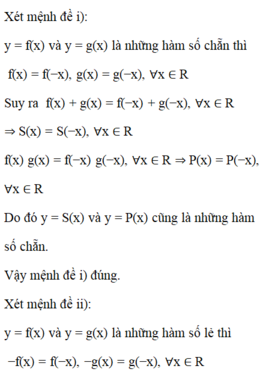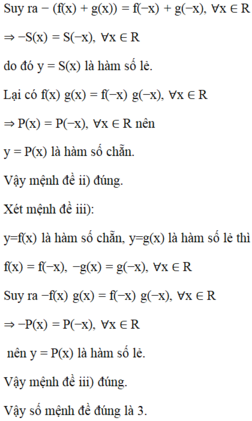Hãy nhập câu hỏi của bạn vào đây, nếu là tài khoản VIP, bạn sẽ được ưu tiên trả lời.

Số 2 lớn hơn mọi giá trị khác của hàm số f(x) = sinx với tập xác định D = R nhưng 2 không phải là giá trị lớn nhất của hàm số này (giá trị lớn nhất là 1); vì vậy A sai. Cũng như vậy B sai với f(x) = sinx, D = R, M = 2. Phát biểu C tự mâu thuẫn: vì M = f( x 0 ), x 0 ∈ D nên hay không xảy ra M > f(x), ∀x ∈ D.
Đáp án: D

Ta có \(f\left(x\right)>0,\forall x\in\left(0;1\right)\)
\(\Leftrightarrow-x^2-2\left(m-1\right)x+2m-1>0,\forall x\left(0;1\right)\)
\(\Leftrightarrow-2m\left(x-1\right)>x^2-2x+1,\forall x\in\left(0;1\right)\) (*)
Vì \(x\in\left(0;1\right)\Rightarrow x-1< 0\) nên (*) \(\Leftrightarrow-2m< \dfrac{x^2-2x+1}{x-1}=x-1=g\left(x\right),\forall x\in\left(0;1\right)\)
\(\Leftrightarrow-2m\le g\left(0\right)=-1\Leftrightarrow m\ge\dfrac{1}{2}\)

a: TXĐ: \(D=R\backslash\left\{-\dfrac{1}{2}\right\}\)
b: TXĐ: \(D=R\backslash\left\{-3;1\right\}\)
c: TXĐ: \(D=\left[-\dfrac{1}{2};3\right]\)

Ta có:
Khi \(x\in\left[-3;0\right]\) thì \(f\left(x\right)\in\left[-4;5\right]\) (dùng BBT)
Lại có:
\(y=f\left(f\left(x\right)\right)=f^2\left(x\right)+6f\left(x\right)+5\)
Khi \(f\left(x\right)\in\left[-4;5\right]\) thì \(f\left(f\left(x\right)\right)\in\left[-4;60\right]\) (dùng BBT)
Do đó, \(m=-4\Leftrightarrow f\left(x\right)=-3\Leftrightarrow x=-2\)
và \(M=60\Leftrightarrow f\left(x\right)=5\Leftrightarrow x=0\)
\(\Rightarrow S=m+M=-4+60=56\)

Bài 1:
\(f\left(-x\right)=\left|\left(-x\right)^3+x\right|=\left|-x^3+x\right|=\left|-\left(x^3-x\right)\right|=\left|x^3-x\right|=f\left(x\right)\)
Vậy hàm số chẵn
Bài 2:
\(f\left(4\right)=4-3=1\\ f\left(-1\right)=2.1+1-3=0\\ b,\text{Thay }x=4;y=1\Leftrightarrow4-3=1\left(\text{đúng}\right)\\ \Leftrightarrow A\left(4;1\right)\in\left(C\right)\\ \text{Thay }x=-1;y=-4\Leftrightarrow2\left(-1\right)^2+1-3=-4\left(\text{vô lí}\right)\\ \Leftrightarrow B\left(-1;-4\right)\notin\left(C\right)\)



Đề bài thiếu rồi bạn, cần hạn chế hàm \(f\left(x\right)\) vì hàm \(f\left(x\right)\) bất kì thì miền xác định D của nó cũng bất kì.
Nếu hàm \(f\left(x\right)\) có miền xác định ko đối xứng (ví dụ \(y=\sqrt{x}\)) thì không thể tách thành 2 hàm chẵn lẻ vì \(f\left(x\right)=g_1\left(x\right)+g_2\left(x\right)\) thì đương nhiên \(g_1\left(x\right)\) và \(g_2\left(x\right)\) cùng miền xác định với \(f\left(x\right)\). Mà một hàm số có miền xác định không đối xứng thì không thể là hàm chẵn hay hàm lẻ.